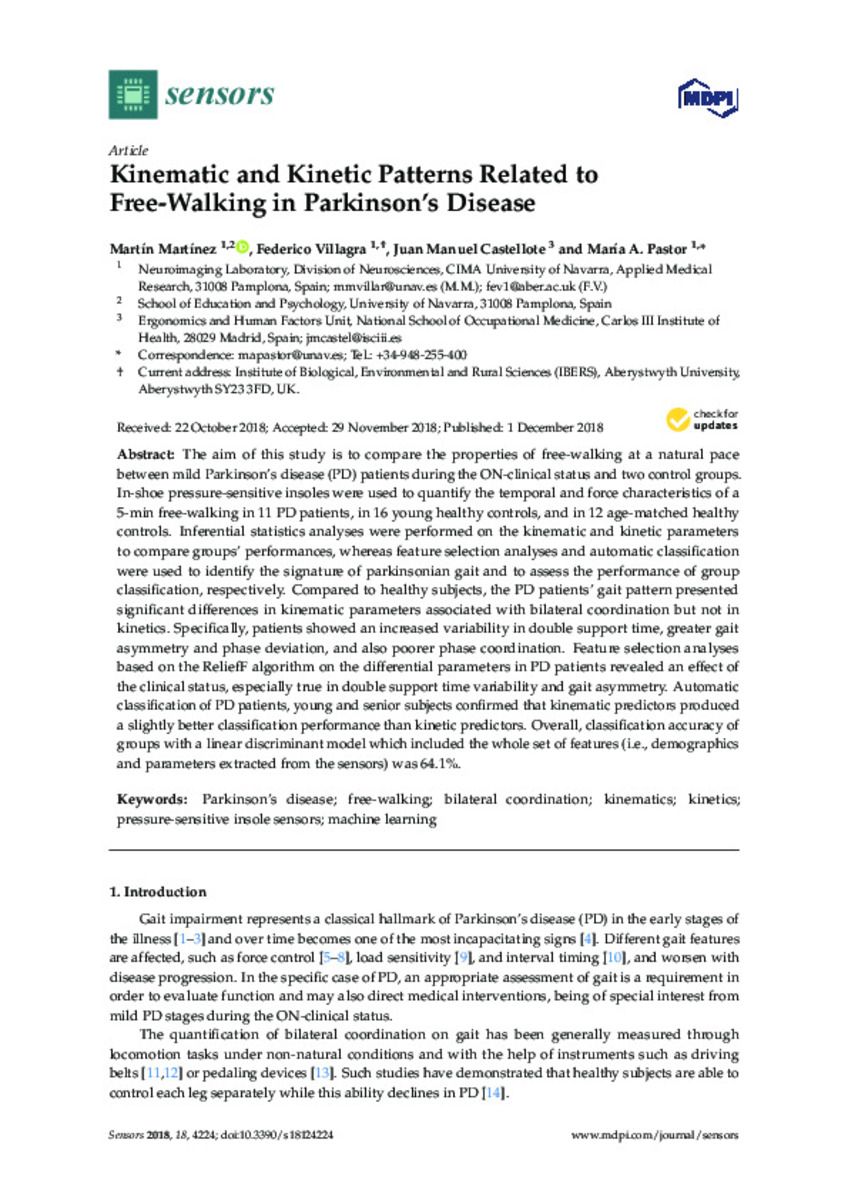Full metadata record
| DC Field | Value | Language |
|---|---|---|
| dc.creator | Martinez, M. (Martín) | - |
| dc.creator | Villagra, F. (Federico) | - |
| dc.creator | Castellote, J.M. (Juan Manuel) | - |
| dc.creator | Pastor, M.A. (María A.) | - |
| dc.date.accessioned | 2022-10-06T08:19:28Z | - |
| dc.date.available | 2022-10-06T08:19:28Z | - |
| dc.date.issued | 2018 | - |
| dc.identifier.citation | Martinez, M. (Martín); Villagra, F. (Federico); Castellote, J.M. (Juan Manuel); et al. "Kinematic and kinetic patterns related to free-walking in Parkinson's disease". SENSORS. 18 (12), 2018, 4224 | es_ES |
| dc.identifier.issn | 1424-8220 | - |
| dc.identifier.uri | https://hdl.handle.net/10171/64394 | - |
| dc.description.abstract | The aim of this study is to compare the properties of free-walking at a natural pace between mild Parkinson’s disease (PD) patients during the ON-clinical status and two control groups. In-shoe pressure-sensitive insoles were used to quantify the temporal and force characteristics of a 5-min free-walking in 11 PD patients, in 16 young healthy controls, and in 12 age-matched healthy controls. Inferential statistics analyses were performed on the kinematic and kinetic parameters to compare groups’ performances, whereas feature selection analyses and automatic classification were used to identify the signature of parkinsonian gait and to assess the performance of group classification, respectively. Compared to healthy subjects, the PD patients’ gait pattern presented significant differences in kinematic parameters associated with bilateral coordination but not in kinetics. Specifically, patients showed an increased variability in double support time, greater gait asymmetry and phase deviation, and also poorer phase coordination. Feature selection analyses based on the ReliefF algorithm on the differential parameters in PD patients revealed an effect of the clinical status, especially true in double support time variability and gait asymmetry. Automatic classification of PD patients, young and senior subjects confirmed that kinematic predictors produced a slightly better classification performance than kinetic predictors. Overall, classification accuracy of groups with a linear discriminant model which included the whole set of features (i.e., demographics and parameters extracted from the sensors) was 64.1% | es_ES |
| dc.description.sponsorship | This research was carried out in part thanks to grants ESPY-1281/15 and ESPY-112/18 from Instituto de Salud Carlos III to J.M.C. | es_ES |
| dc.language.iso | eng | es_ES |
| dc.publisher | MDPI AG | es_ES |
| dc.rights | info:eu-repo/semantics/openAccess | es_ES |
| dc.subject | Parkinson’s disease | es_ES |
| dc.subject | Free-walking | es_ES |
| dc.subject | Bilateral coordination | es_ES |
| dc.subject | Kinematics | es_ES |
| dc.subject | Kinetics | es_ES |
| dc.subject | Pressure-sensitive insole sensors | es_ES |
| dc.subject | Machine learning | es_ES |
| dc.title | Kinematic and kinetic patterns related to free-walking in Parkinson's disease | es_ES |
| dc.type | info:eu-repo/semantics/article | es_ES |
| dc.description.note | This article is an open access article distributed under the terms and conditions of the Creative Commons Attribution (CC BY) license (http://creativecommons.org/licenses/by/4.0/). | es_ES |
| dc.identifier.doi | 10.3390/s18124224 | - |
| dadun.citation.number | 12 | es_ES |
| dadun.citation.publicationName | SENSORS | es_ES |
| dadun.citation.startingPage | 4224 | es_ES |
| dadun.citation.volume | 18 | es_ES |
Files in This Item:
Statistics and impact
Items in Dadun are protected by copyright, with all rights reserved, unless otherwise indicated.






